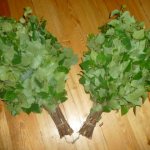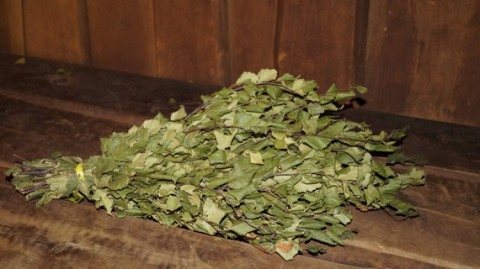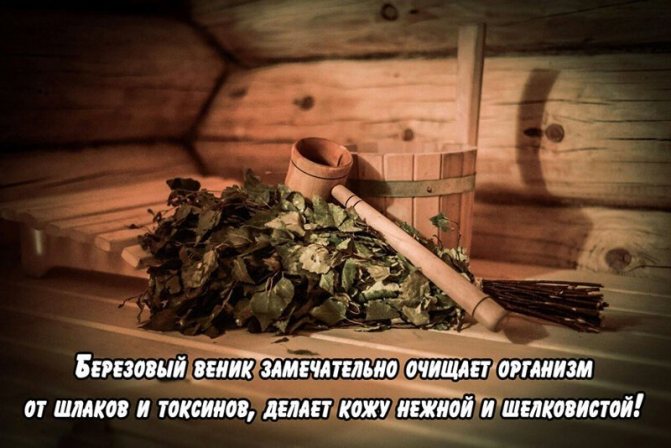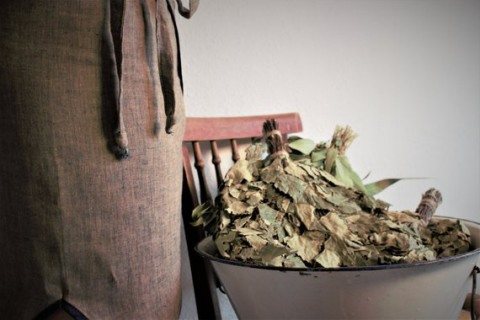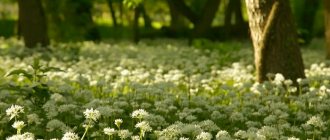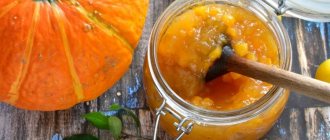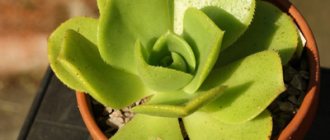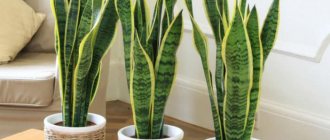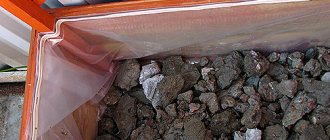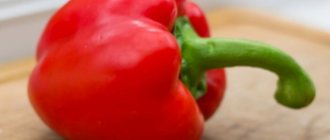An integral attribute of the Russian steam room is a fragrant bath broom. It has many important functions: it promotes relaxation and warming up of the body, produces an intense massage of the skin, refreshes and aromas the air in the steam room.
A high-quality birch broom for a bath can be prepared independently from correctly assembled and tied branches.
Technology of drying brooms from birch branches
Long, strong, flexible branches of weeping birch have long been considered the best raw material for bath brooms. But it is recommended to pay attention to young trees that have never bloomed yet. They are appreciated for their very delicate leaf structure. Gardeners are well aware that removing the root young growth is good for the tree, and use it to harvest brooms.
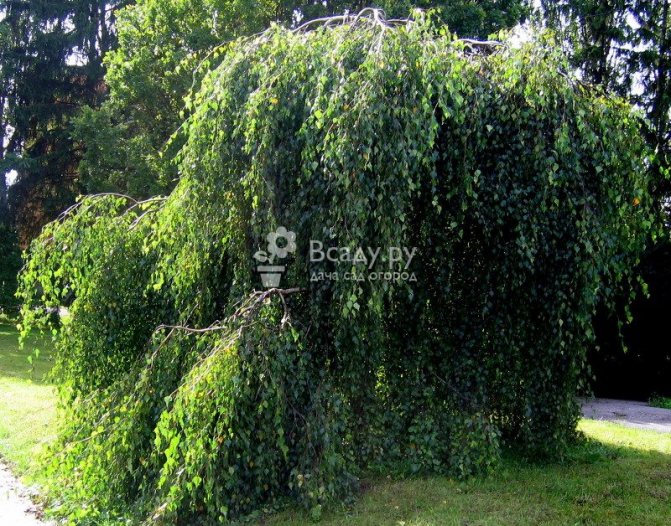
Weeping birch is ideal for making brooms for a bath
For cutting branches, it is advisable to choose a tree that is even and beautiful, without growths. In a sick birch, branches are weakened. The product from them will turn out to be unsuccessful, and will not be useful.
It is not necessary to collect blanks from trees growing along roads in polluted areas. They will do more harm than good. It is best to go to collect branches in a grove or forest. The best option is birch trees growing near water bodies.


A birch by a pond is best suited for harvesting on a broom
The preparation of brooms from specialists begins with a sample of the bottom of the sheet "on the tongue" The surface of a good, suitable sheet is velvety to the touch. Branches with rough leaves - not suitable for use. They make rough products.
The quality of the broom, its softness, aroma, service life is influenced by the correctly chosen moment of collecting the blanks. If you do this at the wrong time, too sooner or later, then later it will become slippery, will not last long, and will quickly fall apart. The branches collected correctly and on time will provide a high-quality product with useful reusable properties.
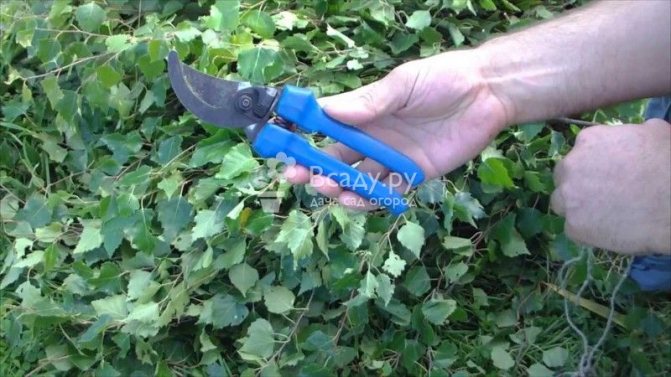

Harvesting birch brooms begins when the leaves are already strong, but flowering has not yet begun
For a long time in Russia, it has been customary to collect blanks a couple of weeks after Trinity. At this moment, the leaves have already grown enough, they have collected the required amount of essential oils, young shoots with high elasticity have appeared. However, when choosing the moment of harvesting, one should take into account the peculiarities of the climate and place of residence.
Harvesting birch brooms is a process honed by our ancestors and requires special preparation. First of all, you need to know about the ripening time of birch, since the quality of the product depends on certain properties of its foliage.
It is important to understand that the development of a leaf has a clear time frame, and other factors can also affect its structure: heat, rain and wind. Based on these criteria, experienced bath attendants determined that the most suitable time for collecting branches on a broom: when the leaves got stronger, but the flowering did not start - that is, the earrings did not appear. Depending on the region and weather conditions, this can be any month of spring. In the Moscow region, you can start harvesting in mid-May.
To get a good birch broom, harvesting should be done early in the morning, when the dew has already disappeared. Only in dry weather. Branches with wet foliage are not good. When dried, their structure will collapse, the foliage will darken and curl.If it rains, you need to wait a few days. Ignoring these nuances will not lead to the desired result. The resulting products will lose most of their useful properties.
As practice has shown, branches of a two-year-old tree growing closer to the ground have better properties. Brooms are the strongest from them. You can cut them with a knife, but it is more convenient with a pruner. For convenience, collectors with extensive experience climb a birch tree, tilt it, and tie it to a tree growing nearby. Such an approach, with the appropriate skill, will not harm the birch, since this tree is flexible and durable.
If the brooms are not knitted immediately, the blanks are provided with storage conditions - for this, attics and hay are used. In a city, the best option is a mezzanine, a balcony. But first, they must be wrapped in paper.
The most effective way is to dry on the roof, for example, outbuildings:
- We lay out hay on the surface;
- We lay the blanks on top with small gaps between them;
- Cover with hay;
- We turn the workpieces over for a month, every two to three days.
If you follow the recommendations, observe the terms of harvesting birch brooms, and the rules for their storage - the products will delight you with their quality and will bring considerable benefit. One is enough for two to three uses.


Knitting of a birch broom for a bath
- Before knitting, the dried workpieces are laid out on a sacking, left to lie down for a couple of days - to “breathe”.
- The size is selected according to individual preferences. Recommended length: 0.4-0.8 m. Large or smaller products are inconvenient to use.
- The place for the pen is thoroughly cleaned of knots and foliage, processed with fine sandpaper.
- Prepared branches are collected together, giving them a flattened shape.
- Thicker twigs are placed inside the product, and thin branches are laid out along the edge, curving inward.
- Distribute the branches in a fan, with leaves in one direction.
The handle is made as follows. Collect the cleaned blanks and fasten them well with a rope closer to the foliage in order to improve the quality of the product. Cloth is wrapped around the handle to prevent calluses. The recommended handle length is 15 cm.
When assembling a product to improve its qualities, you can add branches of chamomile, thyme, red currant. If you want to add conifers and nettles, then it is better to place them in the middle so as not to damage the skin during use.
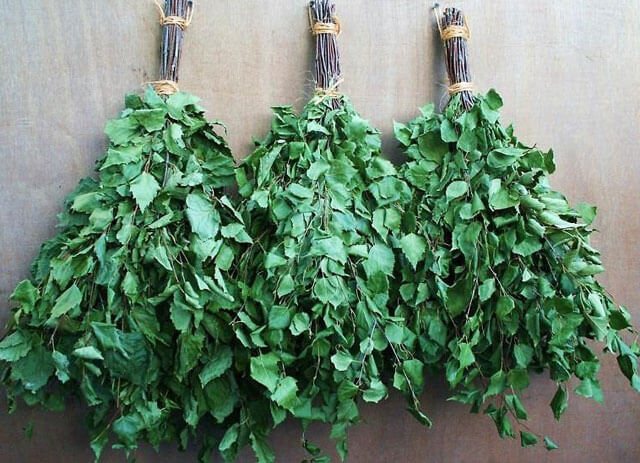

The most optimal time when it is better to harvest brooms for a bath is considered to be the time of flowering of the grass stand. During this period, the leaf becomes tender, soft and fragrant, as well as already strengthened.
Start harvesting on the 49th day after Easter - on Trinity, which usually falls on the beginning of summer. The best time is the first half of the day after dew in dry weather. Finish on "Ilyin's Day", August 2, as according to popular beliefs after this day they no longer have healing powers, except for eucalyptus and oak.
We suggest you familiarize yourself with: Bath masks at home
When you need to prepare brooms for a bath, take into account the following factor, do not use growing raw materials:
- next to the road;
- near industrial enterprises;
- close to high voltage lines.
rules
- Treat plants with care, cut off not all branches in a row with your own hands, but which are necessary.
- Choose young plants, which are about 2-3 years old, their branches bend well.
- Especially prized is the birch that grows near the water, which is called "weeping":
- the best to take branches from the very ground;
- shoots should be thin, flexible, straight, drooping and long;
- the leaf should be velvety, not rough.
- Cut off the side shoots using a pruning shear for convenience.
- Do not transport brooms in bags or other containers. Better to tie them up with a rope and put them open.
- As the folk instruction says, upon arrival, they must be immediately untied so that they do not stick together, otherwise they will not become elastic and loose.
- You can start knitting only 2-3 days after drying them in the back room, where they should be closed from direct sunlight.
- Sort the branches by length before linking.
- Peel about a third of the butt of each twig from the leaves, then the broom will decay less and it will be enough for 2-3 steam rooms.
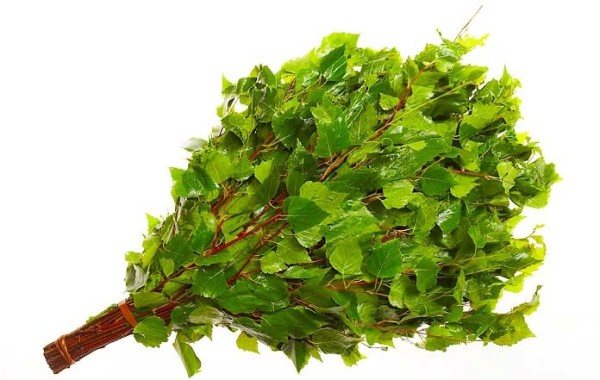

In the photo - a ready-made broom made of birch branches
- Give preference to twigs growing at the bottom of the tree's crown. These are the youngest and most elastic stems.
- The best option for a tree is a young birch that has never bloomed yet. Such a tree has leaves that are delicate, smooth and silky.
- The average length of birch branches is about 50 cm.
- The place where the trees grow plays a role. Those that grow near roads and industrial areas are not suitable. It is better to look for a suitable birch in the forest or in a grove, and even better, so that the tree grows near a lake or river.
- Check the texture of the leaves. They should be silky and with a barely perceptible roughness.
- When to collect birch brooms for a bath? Cutting the stems is necessary when the weather is dry. The fact is that wet leaves, when dried, change their color, curl into a tube, and then fly around.
- Branches for brooms are torn strictly in the first half of the day, approximately until 9 am.
- For cutting branches, a classic "weeping birch" is chosen - a tall tree with elastic, long, unbreakable and falling branches.
- Treat the tree with care. Ideal when only unnecessary branches are broken. This way you thin out the birch.
- June and July birch is good because the leaves already have enough juice, they contain useful substances in high concentration.
|
| A long-standing Russian tradition is to knit 52 brooms for a year, exactly as many as there are weeks in a year. |
In proven bath complexes, bath attendants work with properly prepared birch brooms. In our catalog of St. Petersburg baths, you can choose a suitable institution in order to personally see such an ideal broom and evaluate the quality of massage with an impeccable bath accessory.
- "We reach the handle." Before the weaving procedure, the stems should be cleaned of leaves and small knots by about 15 cm in order to properly prepare the future "handle".
- Form a tight middle. The base is based on thicker and more resilient stems, which will become a reliable "backbone" for the future bath accessory.
- We create volume. We spread thin branches around the base with bends inward. It is easy to check whether you have laid the stems correctly - the leaves should "look" at you with their glossy side.
- We tie the "bath fan" with a textile rope, but not with a wire. Experts insist on tying the stems with a string to avoid injury and burns during broom massage. The ends of the branches can be additionally wrapped with a tape that protects the hands of the attendant from chafing.
- We dry the branches. Tied brooms are hung on a pole or rope. Note! The stems should not be in direct ultraviolet rays (the sun will provoke overheating and curling of leaves) - it is better to hang them in the area of active air circulation (in a draft).
The best place to dry is on a veranda or area in natural shade provided by trees. After drying, the finished bath accessories are stored.
After tying, estimate the weight of the broom, hold it in your hand, perform a few strokes. It shouldn't be too heavy, even though the stems and leaves will dry out. On average, one birch broom takes about twenty stems.
- Classic drying. The brooms are hung from a rope in a row and dried for two or three weeks.
- Dry Finnish. The Finns offer their own proprietary "shock freezing" technology.According to this technique, the accessory is packed in a sealed transparent film and then frozen at a temperature of -40 ° C. For defrosting, it is enough to dip the broom into warm water in the steam room and hold it a little over the stones.
- Technique "broom in the hayloft". Old Russian method of drying brooms in a haystack. Birch brooms are laid on a haystack in a circle, alternating with a layer of hay. With this technology, the broom retains its shape and acquires an even richer aroma.
- Does the color of the leaves on the stems to be cut play a role?
Bath brooms knitting technique
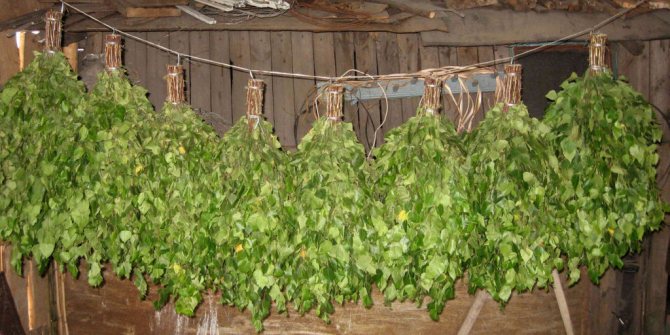

Harvesting birch and oak brooms for a bath consists not only in the correct collection of raw materials, but also in the correct knitting and storage. Often, they are arranged so that the upper branches hide the middle ones under them. Everything is stored under hay, or any fabric of natural origin. In the form of a warehouse, either a warm balcony or a shed is used.
When to cut birch and oak branches
If we are talking about how to knit birch brooms for a bath, then there is a definite period of time on the 11-30th, when there are no earrings on the trees yet.
But it is imperative to take into account the general condition of the foliage:
- in order for a birch broom for a bath to be good, the outer part of the leaf should not be rough, but on the contrary, tenderness and velvety should be felt to the touch;
- when you try to pull on the sheet, only a small part of it should come off, and not the entire plate as a whole.
If we talk about the timing of the preparation of oak brooms for a bath, then they fall on the second half of July or early August. By that time, the leaf should not only get stronger, but also acquire a rich green color in comparison with the young color that is inherent in it at the beginning of summer
We suggest that you familiarize yourself with: Installing a stove in a bath with your own hands
A birch broom has long been used as a universal tool for bathing procedures. The beneficial effect of the broom on the human body is manifested in the following:
- effective cleansing of the skin from accumulated toxins, acne and dead skin cells;
- improvement of blood circulation and lymph flow;
- elimination of aches in muscles and joints with rheumatism and high physical exertion;
- aromatization of air and prevention of diseases of the upper respiratory tract.
To get the maximum therapeutic effect from the use of bundles, you should know when you can harvest birch brooms for a bath.
Properly prepared products will help get rid of frequent back pains, muscles, improve the condition of blood vessels, relax the nervous system and strengthen the immune system. Their main healing property lies in the mild and gentle effect on the bronchi, as well as in the prevention of allergic diseases.
About birch: short, but capacious
Birch is remembered as the heroine of an old Soviet joke, when by the Decree of the Council of Ministers of the USSR it was prescribed to increase by an order of magnitude in the next five-year period the production of birch sap, not only clarified, but also with pulp. But seriously, birch supplies raw materials for many sectors of the national economy. Let's list the most widely known applications:
- The birch supplies the sap. The procurement of an exquisite elixir from the Soviet Union was put on a grand scale and in Soviet grocery stores it was the most affordable at a price - 8 kopecks for a standard gostov glass. By the way, tomato was sold at 10 kopecks, apple at 15, grape at 18 - 20. Crowned the hierarchy was pomegranate, the price of which varied widely, depending on the region. A significant disadvantage of birch sap was considered the fact that it was not customary for them to drink alcohol. Tomato was more popular, the price difference was just 2 kopecks, but it also successfully replaced the appetizer;
- A lot of sports equipment was made from birch. Starting from lances, track and field disks and ending with skis.In the latter role, maple was a serious competitor to birch;
- Hammer handles, mallets, file handles were made of birch wood. First of all, due to the excellent density, homogeneity of wood and a kind of elasticity, which, in the tools listed above, is most welcome;
- Birch plywood and veneer are a kind of classics of the genre. Birch furniture, at one time, was very popular in Scandinavia and Finland;
- If we have already remembered the Finns, then how not to recall the famous Finnish printing, which was carried out on coated paper, the raw material for which was the cellulose of birch trees;
- Birch was used to make wooden knots for Kalashnikov assault rifles;
- Spools for thread were made only from birch;
- She also found application in aviation. During the Great Patriotic War, elements from the wood of this tree were used for irrelevant parts of the airframe set of some aircraft;
- After all, she supplied the "Bursak porridge." The flexible and strong rods of the young growth were considered in the vastness of the Russian Empire to be an excellent educational and preventive pedagogical tool, the moderate use of which increased both discipline and academic performance in primary and secondary educational institutions by an order of magnitude.
But what about the bathhouse? In the bath, birch is also represented more than enough. Let's count:
- Birch firewood. They are highly valued for their good calorific value and peculiar mild aroma. Due to the rather high density and humidity, they require long drying in natural conditions. Typically, it takes 14 to 18 months to fully dry. Birch logs are very good for open fireplaces in the dressing room. Smooth, soft flame, few sparks, beautiful bluish color of fire tongues. Significant disadvantages of birch firewood include their viscosity and difficulty in splitting. Of course, the means of small-scale mechanization help to significantly ease the procurement issues and reduce the problem. The second significant negative point is the tendency to form soot plugs in chimneys, especially when raw wood and birch bark are used as firewood.
- Matches. Every time you kindle a fire in a sauna stove, you need to pay tribute to this light wood, which in droves has provided, and still provides, the needs of match factories for raw materials. By the way, birch bark is very convenient and practical to heat the stove.
- Birch beer mugs. Due to the fact that the wood of this tree is very dense and homogeneous, it is well exposed to manual and mechanized processing, including turning. Birch beer mugs are very popular in Germany. It is considered special chic to serve light wheat in a liter mug with birch bark. We have already discussed in detail how this foamy drink and a bath are associated.
- Finally brooms. Perhaps the most popular and well-known use of birch in the history of human civilization.
Correct knitting
If the broom has become very flat during storage, do not worry. When steamed, it will restore its volume. And he will definitely take his ideal shape to "hug the body" of the bath guest.
|
| The average length of a birch broom is from 40 to 80 cm. |
- How do you know if birch branches are ready for cutting?
Experienced bath attendants who make blanks do just that. If the leaf has a sweetish flavor, it is too early to cut the branches. And, if there is bitterness in the taste, this is what you need!
- How many times will a well-knitted and properly prepared broom last?
With such an accessory, you can safely bathe two or three times. An impeccable birch broom, as if "playing" in the hands of the bathhouse attendant. To wield them is an incredible pleasure, the broom does not slip out of hands, and most importantly, it brings maximum benefit to a person.
|
| Correctly prepared birch brooms will give you a charge of vivacity and health. |
- Is it possible to "mix" birch stems with other plants?
Not just possible, but necessary! Experts advise, when harvesting brooms, to put inside branches of aromatic herbs: mint, yarrow, lavender, chamomile stems, currant twigs, thyme. The healing mix will create a great atmosphere in the steam room, and most importantly - provide a healthy massage.
- How to understand that a broom is prepared according to the rules?
The finished bath accessory has a rich green color on the leaves, and the broom itself has an amazing aroma (something similar to balsamic oil), fluffy, voluminous. After steaming, the aroma will be even more intense.
We are sure that our tips will help you prepare the best birch brooms and get real pleasure from using them!
Cutting branches is possible only during the dry period, since high humidity will lead to their deterioration during the drying process. The leaves, when moisture begins to leave, darken, curl and fly around. If it rains in the region for the period of harvesting branches for a broom, then it is worth cutting a little later.
Usually, when knitting brooms for a bath, they go for suitable branches away from city streets to ecologically clean areas. The branches are pruned before lunchtime, when the morning dew has dried up. It is worth picking up branches of 2 years old, which grow the lowest to the ground (not to be confused with shoots at the roots).
You can trim them with a sharpened pruner. The length should be about 60 centimeters. Observing these conditions, you can get a high-quality, reliable and effective broom for several procedures.
Why is summer the best time to collect birch (or oak) bath brooms? Everything is simple enough. By this time, the leaves not only have time to grow, but also contain the optimal amount of essential oil glands. The branches are elastic, which ensures maximum pleasure from whipping them over the steamed human body.
If the branches are already prepared, then they should be tied, having previously laid out on sacking. A set of branches from already wilted branches is fastened. The thickness of the bunch can vary depending on the tastes of the visitor to the bath, but the broom should be from 40 to 80 centimeters in length so that it is easy enough to use it.
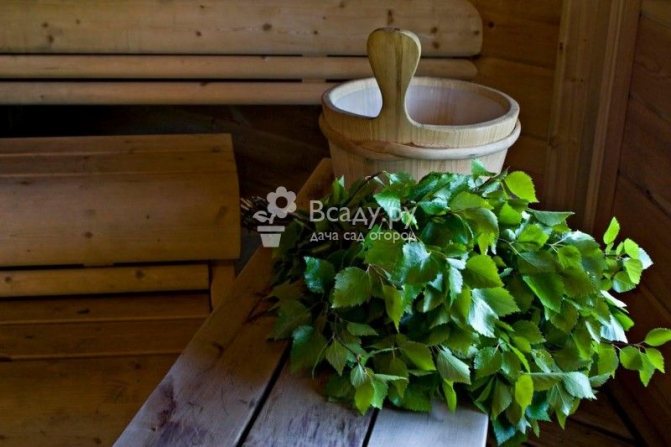

Preparing branches looks like this:
- Branches are stripped of twigs and leaves in the place where the intended handle will be located. Its length should be about a third of the entire broom.
- Thick branches fit inside the knitting, and thin such a frame I cover from the outside, bending them slightly inward. All knitting should be flat at the same time.
- It is important to ensure that when folding the foliage is directed to one side and ultimately the bundle should resemble a fan.
The handle is processed by wrapping the stripped part of the branches with twine. The entire area is scrolled without knots and foliage, and at the end the remnants of branches or material are carefully trimmed. Thus, a neat handle is obtained, which will not lead to the formation of calluses in the process of whipping the visitor to the bath.
Many experts, speaking about how to prepare brooms for a bath, recommend adding stalks of mint, thyme, chamomile or young shoots of black currant between the branches. This will give the product a great aroma and enhance the healing effect of the procedures.
Sometimes, looking at the photo from the bathhouse, you can see that branches of coniferous trees have been added to the broom. It should be said right away that they can be inserted exclusively inside, since the needles can damage the skin when whipping.
The most common mistakes are:
- Harvesting was carried out at the wrong time: if it was too early, then the leaves did not have time to get stronger, and if it was too late, they had already lost their strength.
- Drying was carried out in open places under the influence of direct sunlight.
- Wet branches were used, or they were washed before tying, which is absolutely impossible to do. Dust from the broom can be washed off only after drying and always with boiling water when you first visit the bath.
The best time to start collecting material is the first 14 days after Trinity, when the birch is gaining strength, the foliage acquires a rich green color and contains the maximum amount of useful aromatic substances.
Correct harvesting of birch branches requires observance of important points:
- Quality material can only be obtained from young and strong branches with firm and juicy leaves. In this case, the sheet should be with a flat plate, not damaged and not infected with pests. The main rule is the absence of earrings.
- For a broom, elastic and thin branches should be harvested that can withstand mechanical stress well.
- The collection is best done in ecologically clean areas, remote from highways and industrial areas. The best option is the lower reaches of rivers, a forest edge, a birch grove.
- To obtain a beautiful and functional workpiece, only the lower climbing branches are used.
- It is best to collect material for the broom on a dry and sunny day in the afternoon. Branches cut on a rainy day require careful and lengthy drying. Poor drying can cause rot or mold to appear on branches or foliage.
We suggest that you familiarize yourself with: How to properly conduct the light into the bath with your own hands
To solve the problem with oily skin, frequent rashes and improper functioning of the sebaceous glands, you can use an oak broom. Regular use of such a bundle will leave the skin clean, fresh and silky. It is recommended to harvest the oak leaf for a broom from the second half of August to the first half of September.
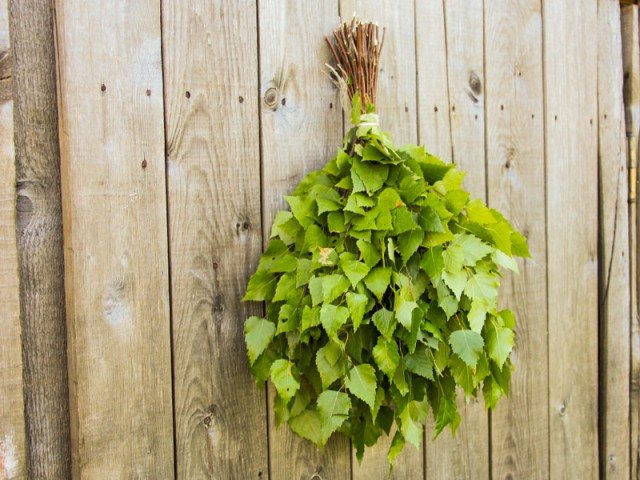

The next important step is knitting the prepared raw materials for a bath broom. To get a quality product, it is recommended to follow some knitting rules:
- The assembly is carried out from resilient and flexible branches with dense, fully blossoming foliage. All undeveloped or damaged leaves are previously removed.
- Branches should have 2 or more branches to give the bundle the necessary density.
- For assembly, it is better to use branches, the length of which is from 40 to 55 cm, the thickness is no more than 5 mm.
- In one knit, there must be the required amount of material so that the diameter of the handle does not exceed 6 cm.
- The prepared branches must be knitted immediately in order to prevent their premature deformation and drying. Further, the resulting knits are subjected to long-term drying.
- The dressing can be double or single, with an indent from the butt by 5 and 12 cm.
- The branches at the formed butt should be trimmed exactly.
If desired, the rope can be replaced with plastic or metal clamps. They allow you to securely fix the handle and adjust its diameter after the product has dried. Optionally, the handle can be tied with cotton tape to prevent excessive heating of the clamps.
There are several simple ways to dry brooms, but they all have a general rule: the collected bunch is dried only outdoors in a dark place. Under the influence of ultraviolet radiation, birch foliage can lose its elasticity, color and shape, and during heat treatment it can fall off.
For drying products, it is better to choose a quiet and secluded place, protected from direct sunlight, precipitation and drafts, for example, an attic room with good ventilation. Experienced bath attendants recommend hanging the bundles with a handle to any base or laying them out on a flat and clean surface.
Turning the workpieces daily will ensure that they dry evenly. At first, the branches are laid out freely, as they dry they can be folded more tightly.
If the matings are dried in the attic, they are suspended from the floor beams and left there until they are completely dry. In this case, the roof will ensure uniform shrinkage of the birch leaf and maintain the shape of the product.
When drying several brooms, it is necessary to provide a minimum distance between them for free air circulation.
If the drying technology is followed, then bunches of birch branches are dense, with dark green foliage and a pleasant aroma.
Technology of drying brooms from birch branches
Experts recommend not tying branches too tightly. Otherwise, the foliage will darken and burn. A properly dried finished product has aromatic, bright green, matte foliage. We offer several correct ways to achieve the desired result.
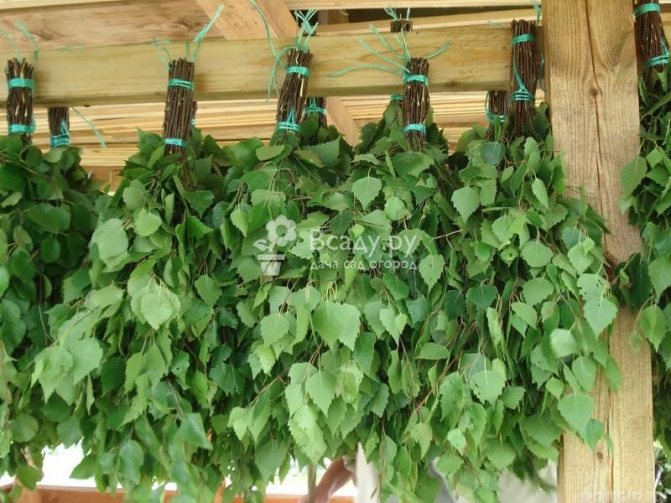

For drying, birch brooms for a bath are hung in a ventilated place.
Products are hung under a canopy in a well-ventilated place so that direct sunlight does not fall. They will dry well within a week. After the brooms can be stacked tightly on shelves in a well-ventilated, dry place, such as shelving in a garage, or storage. They can also be left hanging.
It is believed that a good broom is shaped like a fan. Therefore, it is recommended to place fresh items on the floor. Turn over daily until dry. Otherwise, the products may dry out or dry improperly.
You can dry birch brooms only in the shade!
From the sun, the foliage curls and burns out, the aroma is lost, the appearance deteriorates. An improperly dried broom will crumble as soon as it is steamed. The presence of strong drafts is also unacceptable. The quality of the product can also suffer from them.
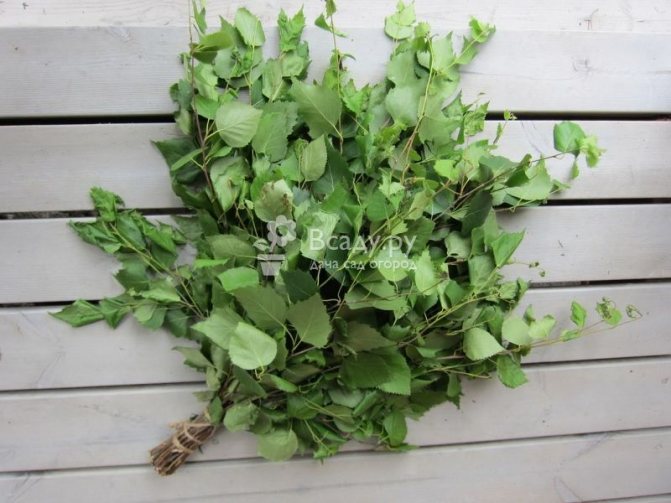

It is believed that a good broom is shaped like a fan.
It is recommended to store brooms carefully, in a cool, ventilated area. Drying using fresh, dried hay preserves the color, shape and aroma of the product as much as possible. Brooms are stacked in it, foliage in the middle. This will give the tree additional beneficial properties, it will become even more aromatic. In an apartment, finished products are stored in bags, paper or plastic.
The final stage of preparing a broom for bath procedures is proper storage. For storage of dried bundles, clean, cool and well-ventilated premises are used - an attic, a barn, a garage, a storeroom, a balcony.
Careless or improper storage can lead to loss of shape of the product and fall of foliage.
If there are many bundles prepared, they can be stacked in batches on a separate shelf. In order to prevent the leaves from stagnating, it is recommended to ventilate the bunches, interchanging them: raise the lower ones up - lower the upper ones down.
If the brooms are stored on the balcony, additional protection from sunlight must be provided, otherwise the leaves will turn yellow and quickly fall off.
How to store brooms for a bath
Dried brooms can be stacked on a shelf or shelf (again, the room should be dry and well ventilated). But from time to time, the brooms need to be rearranged so that those that are at the bottom are in the middle or at the top. Moreover, no light should fall on the brooms: the leaf will turn yellow.
Brooms wrapped in foil can be frozen. Good for those who have a freezer at home
If you have your own hayloft, you can fold the brooms in dry hay, placing them loosely together. Cover the top with dry hay. This is how our ancestors kept them.
For the inhabitants of the apartments, there is also a way of storage: make small holes in a cardboard box, fold the brooms into it without killing, alternating the handle and the crown. In this case, you also need to periodically shift them, lifting the lower ones up.
You can also store brooms in the refrigerator: they are packed in a plastic bag or wrapped in cling film, placed on the bottom shelf, in a dark, dry corner.
As you can see, it is not difficult to knit a bath broom yourself. But this is just the beginning. Brooms, even the most wonderful, can be ruined by steaming it incorrectly. How to avoid such a nuisance, read here. Do not forget to read the article "How to take a steam bath".
Steaming the broom before use
As a rule, the broom is steamed before use. With a freshly made product, this procedure is not done. It can become limp. There are at least two traditional steaming methods.
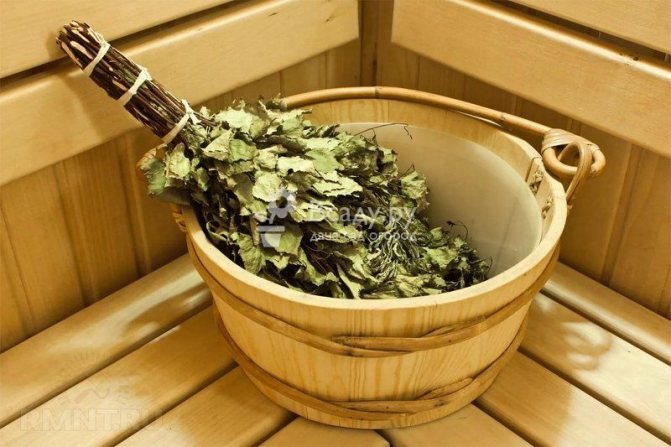

Before use, a birch broom must be steamed
Option one. The dried product is placed in cold water for fifteen minutes, and then in boiling water for a couple of minutes. Too dry brooms are kept in boiling water longer, covering the container where they are located with another container.
The second option is suitable for fresh or freshly harvested brooms. The product must be soaked in boiling water and put on the stones. In this case, it is necessary to periodically rotate, shaking the broom, so as not to get burnt. A couple of such approaches for two minutes will be enough, and you can start bath procedures.
Tags: bath, birch, broom, time, preparation
«Previous post
Steam the bath broom correctly
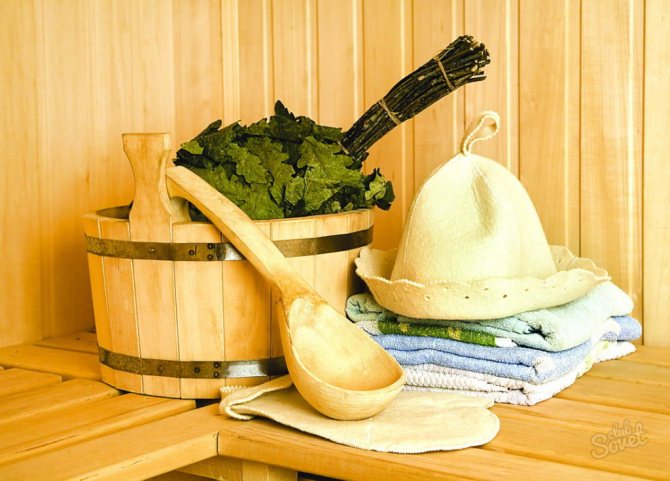

How hard the broom will be depends on the degree of steaming. In order to do this correctly, you need hot water, but not boiling water. If a broom is needed hard, then it can be immersed in water for only twenty minutes. A soft broom is obtained after fifty minutes of steaming. Then the broom is dried over the stove.
Some first dip the brooms in cold water, for about twenty minutes, and immediately dip them in hot water.
A very important point. You can use water for fragrant steam in which the broom was steamed. Also, this water is used as a rinse for the body and hair.
It happens that the broom is dry. Then it is better to wrap it up, or just cover it with a rather damp towel, or leave it in cool water overnight.

